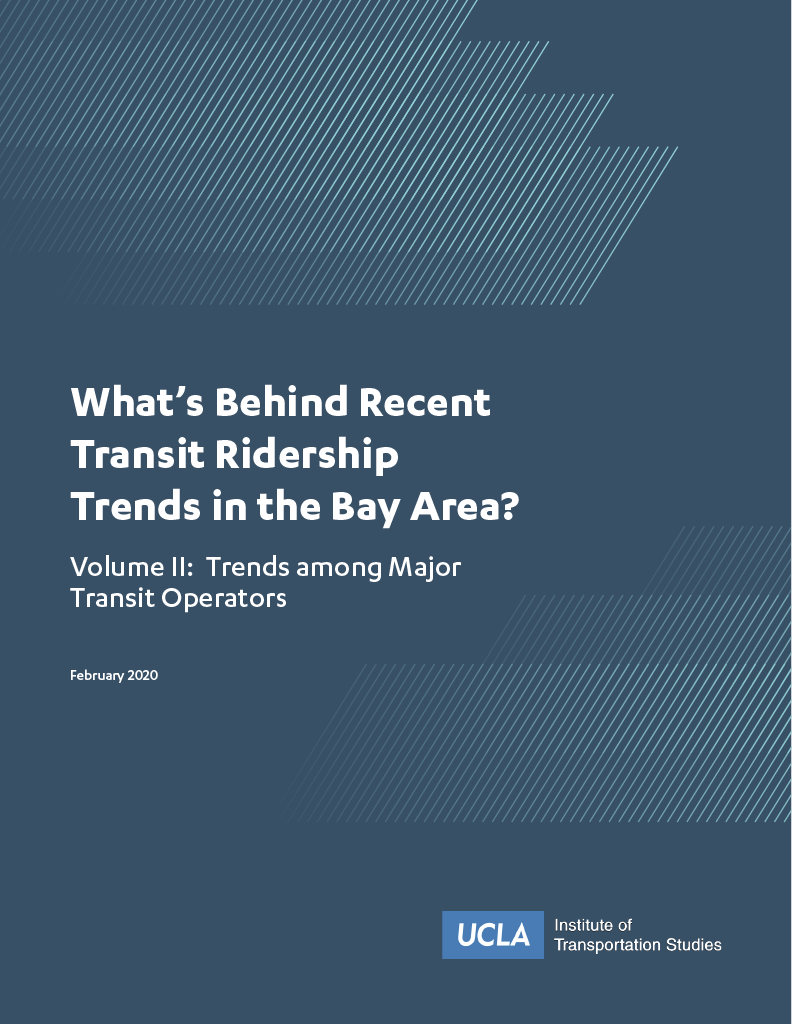Date: February 26, 2020
Author(s): Jacob L. Wasserman, Brian D. Taylor, Evelyn Blumenberg, Mark Garrett, Hannah King, Julene Paul, Madeline Ruvolo, Andrew Schouten
Abstract
Transit ridership in the San Francisco Bay Area is falling. Yet some operators, areas, times, directions, routes, modes, and services have fared better than others. These differences help reveal the causes of the Bay Area’s overall ridership slump and inform policy and service decisions that aim to restore Bay Area transit use. To investigate these temporal and spatial trends, we analyze ridership on the eight largest Bay Area transit operators in considerable detail in Volume II of our report.
Overall, we find a significant level of “peaking.” Ridership losses at off-peak hours, on weekends, on outlying routes, in non-commute directions, and on smaller operators account for a large and disproportionate share of the whole region’s patronage decline. Downtown San Francisco and commute-oriented rail lines like Caltrain have gained ridership as less central, lower-service routes have lost patronage. These patterns match our statistical modeling of BART ridership, on which station-area jobs had the greatest influence, one that has grown over time. The most significant exceptions to the Bay Area’s peaking problem are operators in urban cores, like Muni and AC Transit, where residential and employment density throughout the network have blunted peaking, though not necessarily overall losses.
Absolute patronage declines and peaking are intertwined but distinct problems, with cross-cutting divisions. Yet on all agencies, we see at least some evidence of peaking. The resulting dependence on peak trips both incurs high costs and depresses passenger satisfaction.
About the Project
Public transit ridership has been falling nationally and in California since 2014. The San Francisco Bay Area, with the state’s highest rates of transit use, had until recently resisted those trends, especially compared to Greater Los Angeles. However, in 2017 and 2018 the region lost over five percent (>27 million) of its annual riders, despite a booming economy and service increases. This report examines Bay Area transit ridership to understand the dimensions of changing transit use, its possible causes, and potential solutions. We find that: 1) the steepest ridership losses have come on buses, at off-peak times, on weekends, in non-commute directions, on outlying lines, and on operators that do not serve the region’s core employment clusters; 2) transit trips in the region are increasingly commute-focused, particularly into and out of downtown San Francisco; 3) transit commuters are increasingly non-traditional transit users, such as those with higher incomes and automobile access; 4) the growing job-housing imbalance in the Bay Area is related to rising housing costs and likely depressing transit ridership as more residents live in less transit-friendly parts of the region; and 5) ridehail is substituting for some transit trips, particularly in the off-peak. Arresting falling transit use will likely require action both by transit operators (to address peak capacity constraints; improve off-peak service; ease fare payments; adopt fare structures that attract off-peak riders; and better integrate transit with new mobility options) and public policymakers in other realms (to better meter and manage private vehicle use and to increase the supply and affordability of housing near job centers).


